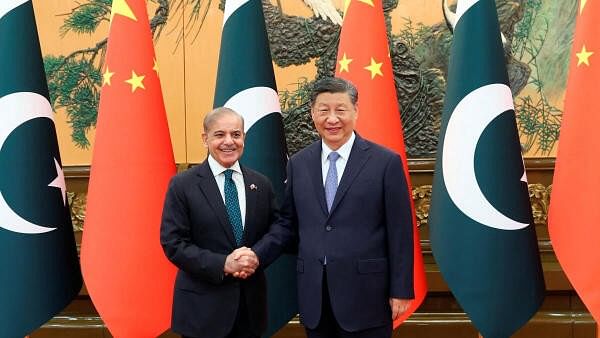
Chinese President Xi Jinping meets with Pakistani Prime Minister Shehbaz Sharif in Beijing
Credit: Reuters Photo
Pakistan Prime Minister Shehbaz Sharif recently concluded his first visit to China from June 4 to 8. Sharif met with Chinese President Xi Jinping and Premier Li Qiang. Sharif was accompanied by a 79-strong business delegation of members representing agriculture, mining, industry, and information technology. This underscored the areas where Islamabad is keen to build with Beijing’s co-operation.
The focus of the visit was to get a renewed push for investments under the China-Pakistan Economic Corridor (CPEC). Pakistan was also hopeful to gain a new plan for repaying the debt it owed China. This restructuring is crucial for Islamabad to win a $8 billion bailout from the International Monetary Fund (IMF). As per China, only 13 per cent of Pakistan’s external debt is owed to Beijing; however, the IMF puts this figure to around 30 per cent. Pakistan owes $125 billion in external debt and about one-third of this is owed to Beijing.
Though the visit was announced months in advance, Pakistan’s annual budget was pushed by two days to wait for the outcome of Sharif’s China visit, making this trip vital to Islamabad’s economic future. Pakistan hopes to gain new investments and commitments, but nothing concrete seems to have been achieved despite 23 agreements and a Memorandum of Understanding being signed.
A major focus was the renewal of investments and projects under the CPEC. A decade after it started, nothing major has been achieved as the $64-billion investment has consistently faced challenges. From India’s resistance to the Covid-19 outbreak, the project has faced hurdles one after the other. The most prominent challenge has been the safety of the Chinese nationals working in Pakistan, with violence against them increasing in the last few years. No wonder Xi while meeting Sharif said that he hoped Pakistan would “continue to create a safe, stable, and predictable business environment and earnestly guarantee the safety of Chinese personnel, projects, and institutions in Pakistan”.
Gwadar Port, a flagship project under the CPEC, has also been underperforming. Though the China-Pak Investment Corporation wants us to believe that the port is successful, “the empty port site suggests the opposite”.
The fact that Sharif decided to visit Beijing before presenting Pakistan’s budget underscores the centrality of China to its financial stability. Pakistan’s domestic economy is struggling and one can argue that challenges are rooted in the Chinese investments, especially the CPEC. The energy and infrastructure projects have not been successful in garnering domestic development. In addition, the delays have intensified Pakistan’s debt challenges.
Does Pakistan need a CPEC 2.0 given its current financial challenges? The budget which was presented on June 12 has proposed a growth rate of 3.6 per cent with an inflation rate of 12 per cent. Islamabad has also increased taxes for FY2024-2025 across segments with a tax revenue target set at $46 billion. However, just 5 million people out of a total of 240 million pay taxes in Pakistan.
The CPEC and the investments promised under it are crucial for Islamabad to increase connectivity and mitigate the growing energy and electricity challenges. Pakistan owes more than $7.5 billion in project debt to power plants set up under CPEC, and owes $~2 billion in unpaid bills to Chinese power producers. With respect to the Gwadar Port, 90 per cent of the revenue earned goes to the Chinese company operating the port.
The lukewarm commitment from Beijing has delayed these projects and has only added to Pakistan’s economic woes. The upgrade of infrastructure is necessary for connectivity, which is crucial for economic growth. However, the cost of such connectivity is further pushing Pakistan into a debt trap. Interestingly, Pakistan’s Federal Minister for Planning, Development, and Special Initiatives Ahsan Iqbal asserted that Chinese investments are quite attractive for Islamabad and “slammed the so-called debt trap narrative as far from reality and expressed appreciation for China's financial support”.
All this paints a grim picture of Pakistan’s economy, and future. China's increasing stranglehold over Pakistan is bad news for India, for the region, and internationally. This level of dependence can be regarded as a step closer to the loss of sovereignty for the nation.
(Gunjan Singh is Associate Professor, OP Jindal Global University.)
Disclaimer: The views expressed above are the author's own. They do not necessarily reflect the views of DH.